Taiwanese vs Spaniard Community Comparison
COMPARE
Taiwanese
Spaniard
Social Comparison
Social Comparison
Taiwanese
Spaniards
6,532
SOCIAL INDEX
62.8/ 100
SOCIAL RATING
151st/ 347
SOCIAL RANK
3,805
SOCIAL INDEX
35.6/ 100
SOCIAL RATING
210th/ 347
SOCIAL RANK
Spaniard Integration in Taiwanese Communities
The statistical analysis conducted on geographies consisting of 31,295,008 people shows a weak negative correlation between the proportion of Spaniards within Taiwanese communities in the United States with a correlation coefficient (R) of -0.282. On average, for every 1% (one percent) increase in Taiwanese within a typical geography, there is a decrease of 0.274% in Spaniards. To illustrate, in a geography comprising of 100,000 individuals, a rise of 1,000 Taiwanese corresponds to a decrease of 273.7 Spaniards.
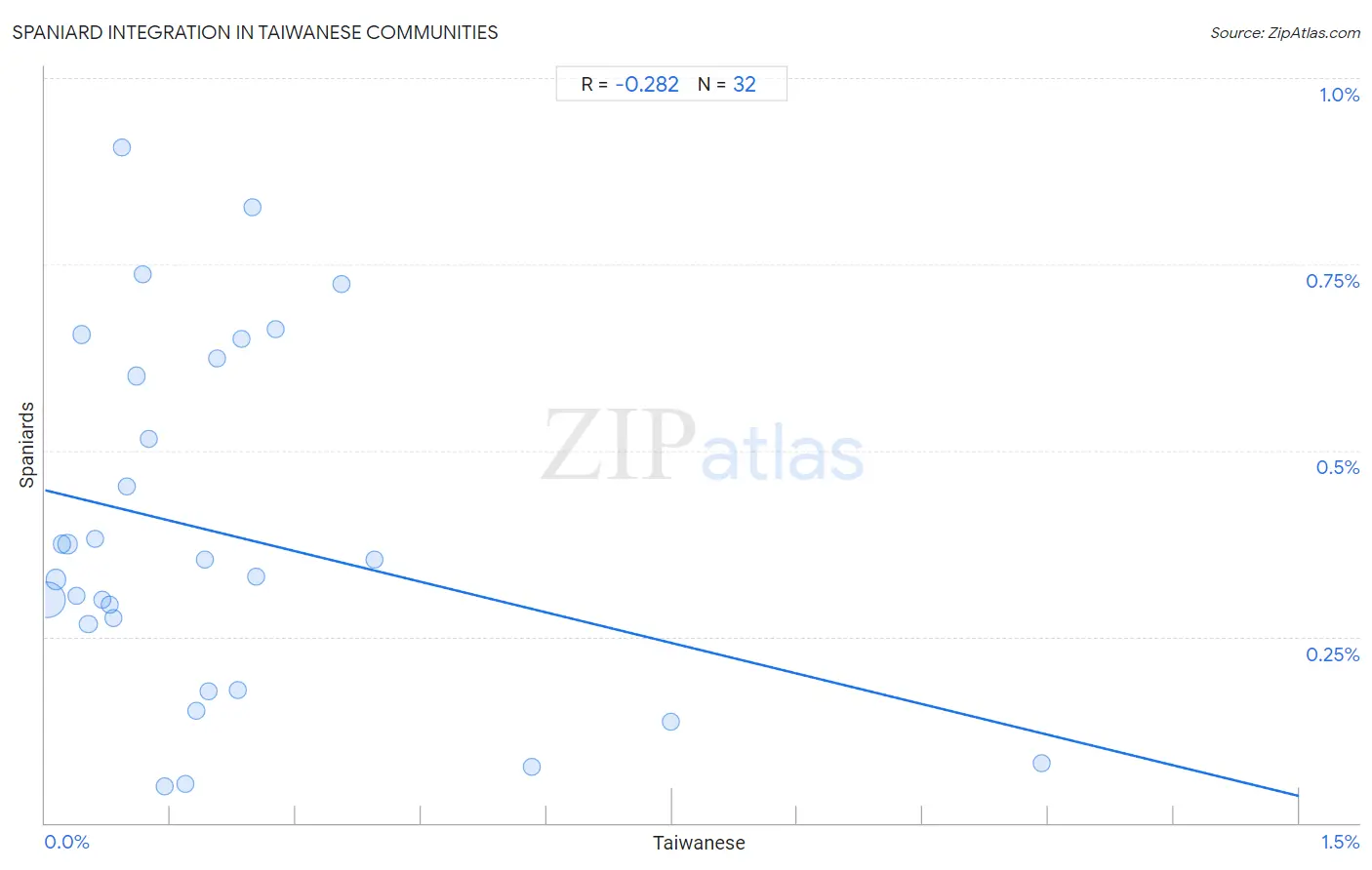
Taiwanese vs Spaniard Income
When considering income, the most significant differences between Taiwanese and Spaniard communities in the United States are seen in householder income ages 25 - 44 years ($101,492 compared to $93,366, a difference of 8.7%), per capita income ($46,455 compared to $43,028, a difference of 8.0%), and wage/income gap (25.1% compared to 27.0%, a difference of 7.2%). Conversely, both communities are more comparable in terms of median male earnings ($55,556 compared to $54,401, a difference of 2.1%), householder income under 25 years ($49,804 compared to $51,117, a difference of 2.6%), and householder income over 65 years ($62,894 compared to $60,866, a difference of 3.3%).

| Income Metric | Taiwanese | Spaniard |
| Per Capita Income | Exceptional $46,455 | Fair $43,028 |
| Median Family Income | Exceptional $107,295 | Fair $101,617 |
| Median Household Income | Exceptional $89,900 | Average $84,644 |
| Median Earnings | Excellent $47,902 | Fair $46,059 |
| Median Male Earnings | Good $55,556 | Average $54,401 |
| Median Female Earnings | Excellent $40,576 | Poor $38,656 |
| Householder Age | Under 25 years | Tragic $49,804 | Tragic $51,117 |
| Householder Age | 25 - 44 years | Exceptional $101,492 | Fair $93,366 |
| Householder Age | 45 - 64 years | Excellent $104,180 | Average $99,889 |
| Householder Age | Over 65 years | Excellent $62,894 | Average $60,866 |
| Wage/Income Gap | Excellent 25.1% | Tragic 27.0% |
Taiwanese vs Spaniard Poverty
When considering poverty, the most significant differences between Taiwanese and Spaniard communities in the United States are seen in single male poverty (10.9% compared to 13.7%, a difference of 25.9%), child poverty under the age of 5 (14.5% compared to 18.1%, a difference of 24.9%), and female poverty among 25-34 year olds (11.8% compared to 14.6%, a difference of 23.9%). Conversely, both communities are more comparable in terms of seniors poverty over the age of 65 (11.2% compared to 10.9%, a difference of 2.0%), seniors poverty over the age of 75 (12.6% compared to 12.2%, a difference of 3.3%), and female poverty among 18-24 year olds (21.2% compared to 20.5%, a difference of 3.6%).
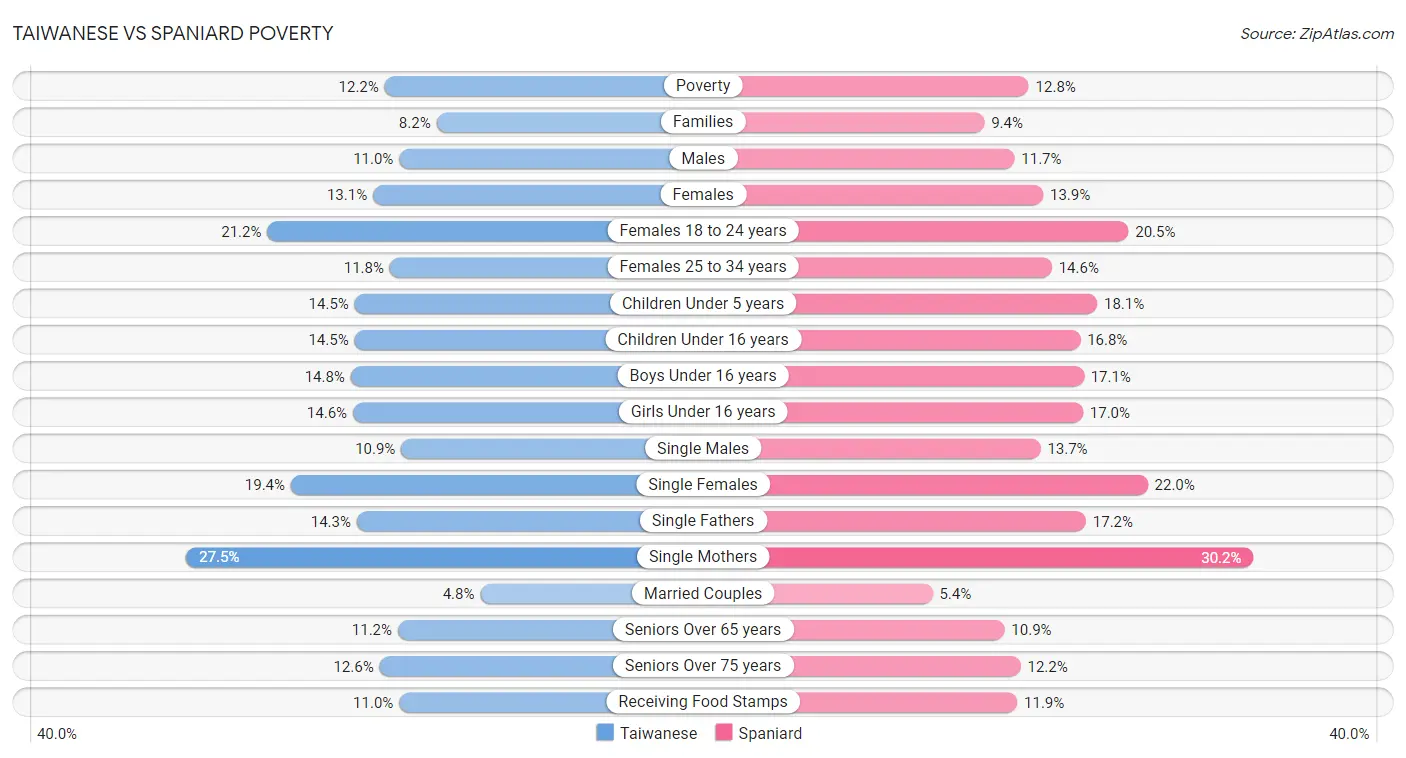
| Poverty Metric | Taiwanese | Spaniard |
| Poverty | Good 12.2% | Poor 12.8% |
| Families | Exceptional 8.2% | Fair 9.4% |
| Males | Good 11.0% | Poor 11.7% |
| Females | Good 13.1% | Poor 13.9% |
| Females 18 to 24 years | Tragic 21.2% | Poor 20.5% |
| Females 25 to 34 years | Exceptional 11.8% | Tragic 14.6% |
| Children Under 5 years | Exceptional 14.5% | Poor 18.1% |
| Children Under 16 years | Exceptional 14.5% | Fair 16.8% |
| Boys Under 16 years | Exceptional 14.8% | Fair 17.1% |
| Girls Under 16 years | Exceptional 14.6% | Fair 17.0% |
| Single Males | Exceptional 10.9% | Tragic 13.7% |
| Single Females | Exceptional 19.4% | Tragic 22.0% |
| Single Fathers | Exceptional 14.3% | Tragic 17.2% |
| Single Mothers | Exceptional 27.5% | Tragic 30.2% |
| Married Couples | Exceptional 4.8% | Fair 5.4% |
| Seniors Over 65 years | Fair 11.2% | Average 10.9% |
| Seniors Over 75 years | Poor 12.6% | Average 12.2% |
| Receiving Food Stamps | Excellent 11.0% | Fair 11.9% |
Taiwanese vs Spaniard Unemployment
When considering unemployment, the most significant differences between Taiwanese and Spaniard communities in the United States are seen in unemployment among women with children ages 6 to 17 years (6.5% compared to 9.2%, a difference of 42.6%), unemployment among seniors over 75 years (6.6% compared to 8.9%, a difference of 35.5%), and unemployment among women with children under 6 years (6.1% compared to 7.8%, a difference of 28.2%). Conversely, both communities are more comparable in terms of male unemployment (5.3% compared to 5.3%, a difference of 0.16%), unemployment (5.3% compared to 5.3%, a difference of 0.46%), and female unemployment (5.3% compared to 5.3%, a difference of 1.2%).
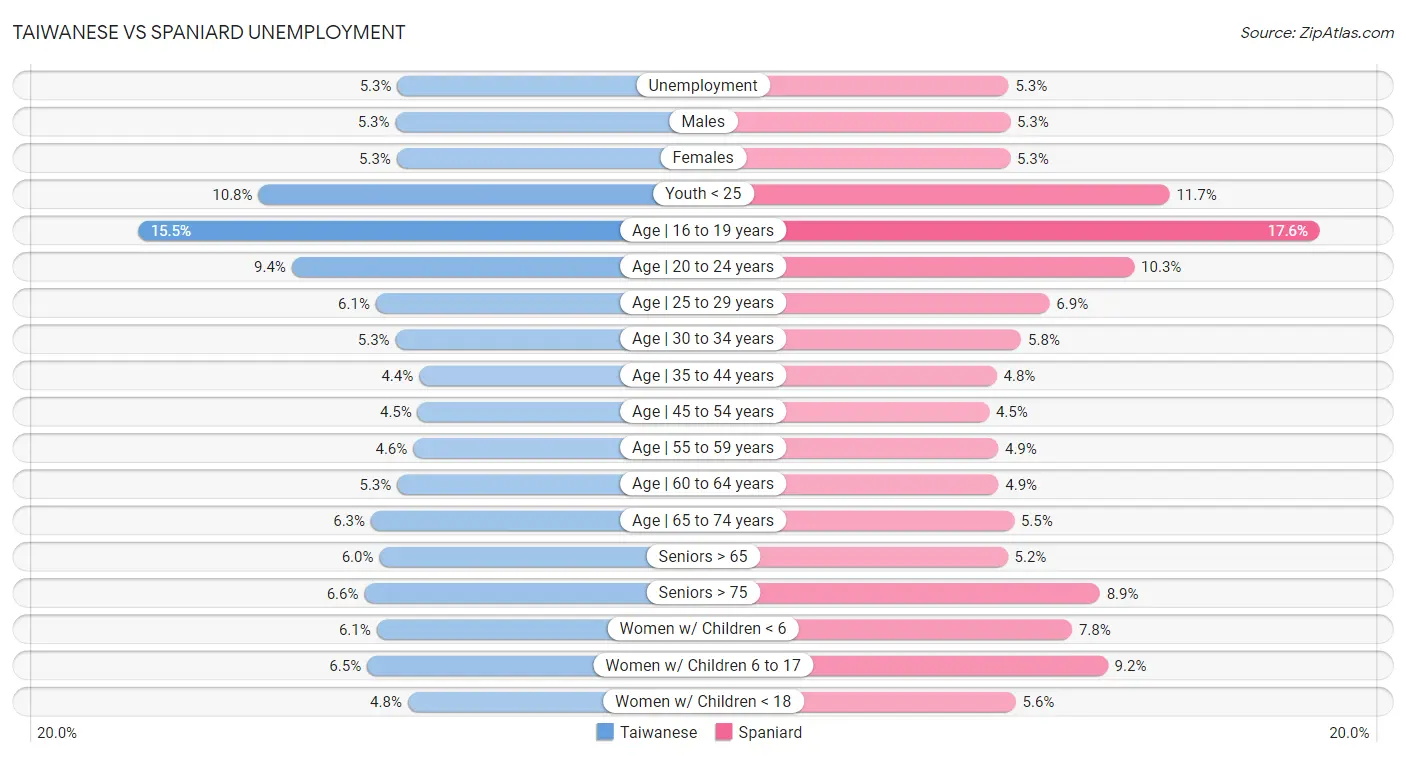
| Unemployment Metric | Taiwanese | Spaniard |
| Unemployment | Average 5.3% | Average 5.3% |
| Males | Fair 5.3% | Fair 5.3% |
| Females | Average 5.3% | Fair 5.3% |
| Youth < 25 | Exceptional 10.8% | Fair 11.7% |
| Age | 16 to 19 years | Exceptional 15.5% | Average 17.6% |
| Age | 20 to 24 years | Exceptional 9.4% | Good 10.3% |
| Age | 25 to 29 years | Exceptional 6.1% | Tragic 6.9% |
| Age | 30 to 34 years | Good 5.3% | Tragic 5.8% |
| Age | 35 to 44 years | Exceptional 4.4% | Poor 4.8% |
| Age | 45 to 54 years | Good 4.5% | Average 4.5% |
| Age | 55 to 59 years | Exceptional 4.6% | Fair 4.9% |
| Age | 60 to 64 years | Tragic 5.3% | Fair 4.9% |
| Age | 65 to 74 years | Tragic 6.3% | Tragic 5.5% |
| Seniors > 65 | Tragic 6.0% | Tragic 5.2% |
| Seniors > 75 | Exceptional 6.6% | Fair 8.9% |
| Women w/ Children < 6 | Exceptional 6.1% | Fair 7.8% |
| Women w/ Children 6 to 17 | Exceptional 6.5% | Tragic 9.2% |
| Women w/ Children < 18 | Exceptional 4.8% | Fair 5.6% |
Taiwanese vs Spaniard Labor Participation
When considering labor participation, the most significant differences between Taiwanese and Spaniard communities in the United States are seen in in labor force | age 16-19 (33.8% compared to 38.0%, a difference of 12.3%), in labor force | age > 16 (66.2% compared to 64.1%, a difference of 3.2%), and in labor force | age 45-54 (83.4% compared to 81.5%, a difference of 2.4%). Conversely, both communities are more comparable in terms of in labor force | age 20-24 (74.7% compared to 75.5%, a difference of 1.0%), in labor force | age 30-34 (84.6% compared to 83.6%, a difference of 1.1%), and in labor force | age 35-44 (85.1% compared to 83.4%, a difference of 2.0%).

| Labor Participation Metric | Taiwanese | Spaniard |
| In Labor Force | Age > 16 | Exceptional 66.2% | Tragic 64.1% |
| In Labor Force | Age 20-64 | Exceptional 80.2% | Tragic 78.4% |
| In Labor Force | Age 16-19 | Tragic 33.8% | Exceptional 38.0% |
| In Labor Force | Age 20-24 | Fair 74.7% | Excellent 75.5% |
| In Labor Force | Age 25-29 | Exceptional 85.4% | Tragic 83.7% |
| In Labor Force | Age 30-34 | Fair 84.6% | Tragic 83.6% |
| In Labor Force | Age 35-44 | Exceptional 85.1% | Tragic 83.4% |
| In Labor Force | Age 45-54 | Exceptional 83.4% | Tragic 81.5% |
Taiwanese vs Spaniard Family Structure
When considering family structure, the most significant differences between Taiwanese and Spaniard communities in the United States are seen in births to unmarried women (29.0% compared to 33.6%, a difference of 16.0%), single father households (2.2% compared to 2.5%, a difference of 13.1%), and single mother households (5.8% compared to 6.5%, a difference of 12.4%). Conversely, both communities are more comparable in terms of average family size (3.23 compared to 3.23, a difference of 0.13%), currently married (45.8% compared to 46.8%, a difference of 2.2%), and married-couple households (45.9% compared to 47.2%, a difference of 2.7%).

| Family Structure Metric | Taiwanese | Spaniard |
| Family Households | Tragic 63.3% | Exceptional 65.1% |
| Family Households with Children | Tragic 26.7% | Exceptional 28.0% |
| Married-couple Households | Fair 45.9% | Excellent 47.2% |
| Average Family Size | Average 3.23 | Average 3.23 |
| Single Father Households | Exceptional 2.2% | Tragic 2.5% |
| Single Mother Households | Exceptional 5.8% | Fair 6.5% |
| Currently Married | Poor 45.8% | Average 46.8% |
| Divorced or Separated | Exceptional 11.5% | Tragic 12.7% |
| Births to Unmarried Women | Exceptional 29.0% | Tragic 33.6% |
Taiwanese vs Spaniard Vehicle Availability
When considering vehicle availability, the most significant differences between Taiwanese and Spaniard communities in the United States are seen in no vehicles in household (11.7% compared to 8.4%, a difference of 39.3%), 3 or more vehicles in household (20.0% compared to 22.3%, a difference of 11.4%), and 2 or more vehicles in household (53.9% compared to 59.2%, a difference of 9.9%). Conversely, both communities are more comparable in terms of 1 or more vehicles in household (88.4% compared to 91.8%, a difference of 3.8%), 4 or more vehicles in household (7.0% compared to 7.6%, a difference of 8.4%), and 2 or more vehicles in household (53.9% compared to 59.2%, a difference of 9.9%).

| Vehicle Availability Metric | Taiwanese | Spaniard |
| No Vehicles Available | Tragic 11.7% | Exceptional 8.4% |
| 1+ Vehicles Available | Tragic 88.4% | Exceptional 91.8% |
| 2+ Vehicles Available | Tragic 53.9% | Exceptional 59.2% |
| 3+ Vehicles Available | Excellent 20.0% | Exceptional 22.3% |
| 4+ Vehicles Available | Exceptional 7.0% | Exceptional 7.6% |
Taiwanese vs Spaniard Education Level
When considering education level, the most significant differences between Taiwanese and Spaniard communities in the United States are seen in no schooling completed (2.5% compared to 1.9%, a difference of 30.0%), professional degree (5.0% compared to 4.4%, a difference of 12.7%), and doctorate degree (2.1% compared to 1.9%, a difference of 10.1%). Conversely, both communities are more comparable in terms of nursery school (97.6% compared to 98.2%, a difference of 0.60%), kindergarten (97.5% compared to 98.1%, a difference of 0.60%), and 1st grade (97.5% compared to 98.1%, a difference of 0.61%).
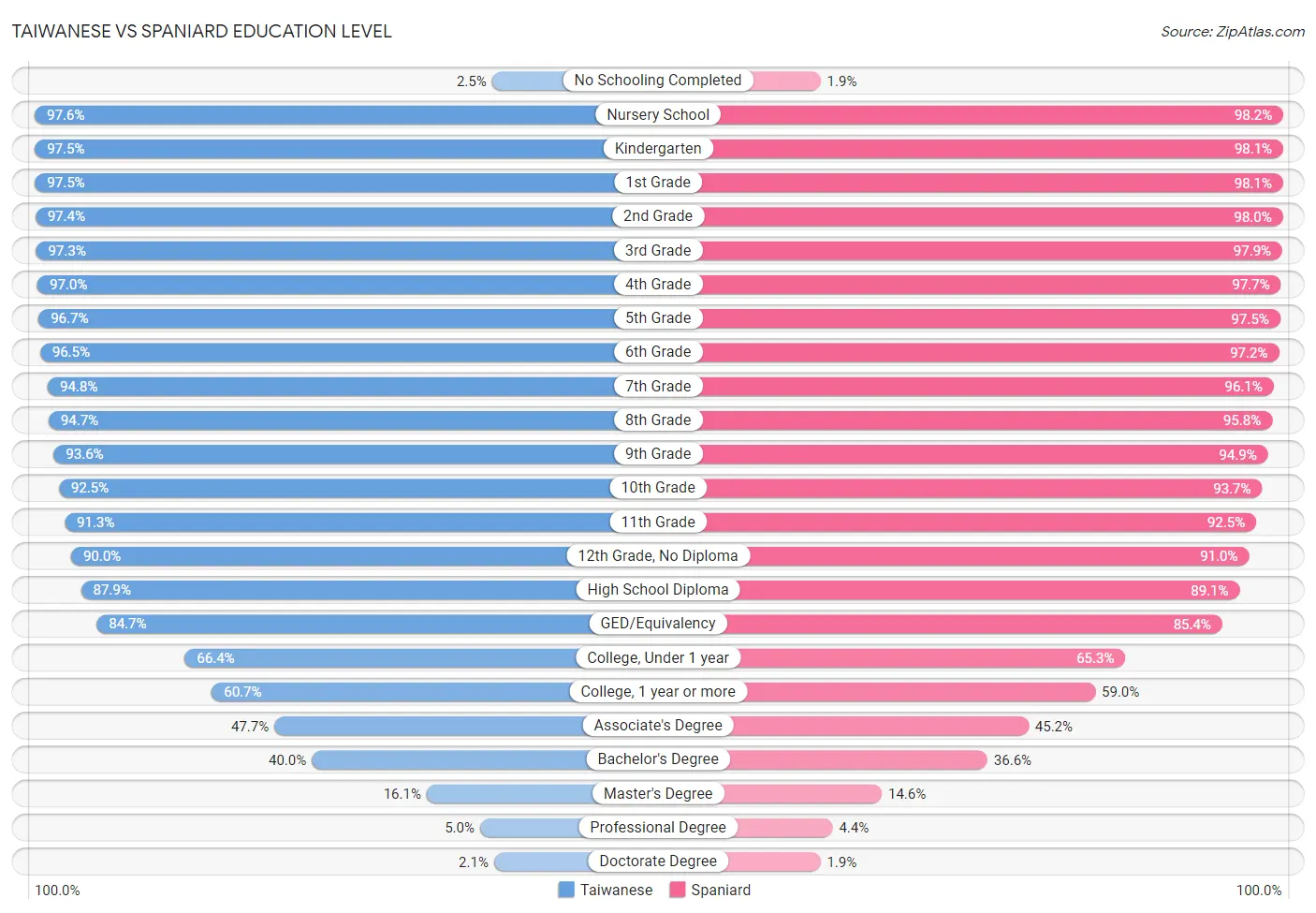
| Education Level Metric | Taiwanese | Spaniard |
| No Schooling Completed | Tragic 2.5% | Exceptional 1.9% |
| Nursery School | Tragic 97.6% | Exceptional 98.2% |
| Kindergarten | Tragic 97.5% | Exceptional 98.1% |
| 1st Grade | Tragic 97.5% | Exceptional 98.1% |
| 2nd Grade | Tragic 97.4% | Exceptional 98.0% |
| 3rd Grade | Tragic 97.3% | Excellent 97.9% |
| 4th Grade | Tragic 97.0% | Excellent 97.7% |
| 5th Grade | Tragic 96.7% | Excellent 97.5% |
| 6th Grade | Tragic 96.5% | Excellent 97.2% |
| 7th Grade | Tragic 94.8% | Good 96.1% |
| 8th Grade | Tragic 94.7% | Good 95.8% |
| 9th Grade | Tragic 93.6% | Average 94.9% |
| 10th Grade | Tragic 92.5% | Average 93.7% |
| 11th Grade | Tragic 91.3% | Average 92.5% |
| 12th Grade, No Diploma | Tragic 90.0% | Fair 91.0% |
| High School Diploma | Tragic 87.9% | Average 89.1% |
| GED/Equivalency | Tragic 84.7% | Fair 85.4% |
| College, Under 1 year | Good 66.4% | Average 65.3% |
| College, 1 year or more | Excellent 60.7% | Fair 59.0% |
| Associate's Degree | Excellent 47.7% | Fair 45.2% |
| Bachelor's Degree | Exceptional 40.0% | Fair 36.6% |
| Master's Degree | Exceptional 16.1% | Fair 14.6% |
| Professional Degree | Exceptional 5.0% | Average 4.4% |
| Doctorate Degree | Exceptional 2.1% | Good 1.9% |
Taiwanese vs Spaniard Disability
When considering disability, the most significant differences between Taiwanese and Spaniard communities in the United States are seen in vision disability (1.9% compared to 2.4%, a difference of 25.3%), hearing disability (2.8% compared to 3.5%, a difference of 25.0%), and disability age 35 to 64 (9.8% compared to 12.3%, a difference of 24.5%). Conversely, both communities are more comparable in terms of disability age over 75 (48.2% compared to 48.1%, a difference of 0.15%), cognitive disability (17.6% compared to 17.3%, a difference of 1.5%), and disability age under 5 (1.3% compared to 1.4%, a difference of 3.2%).
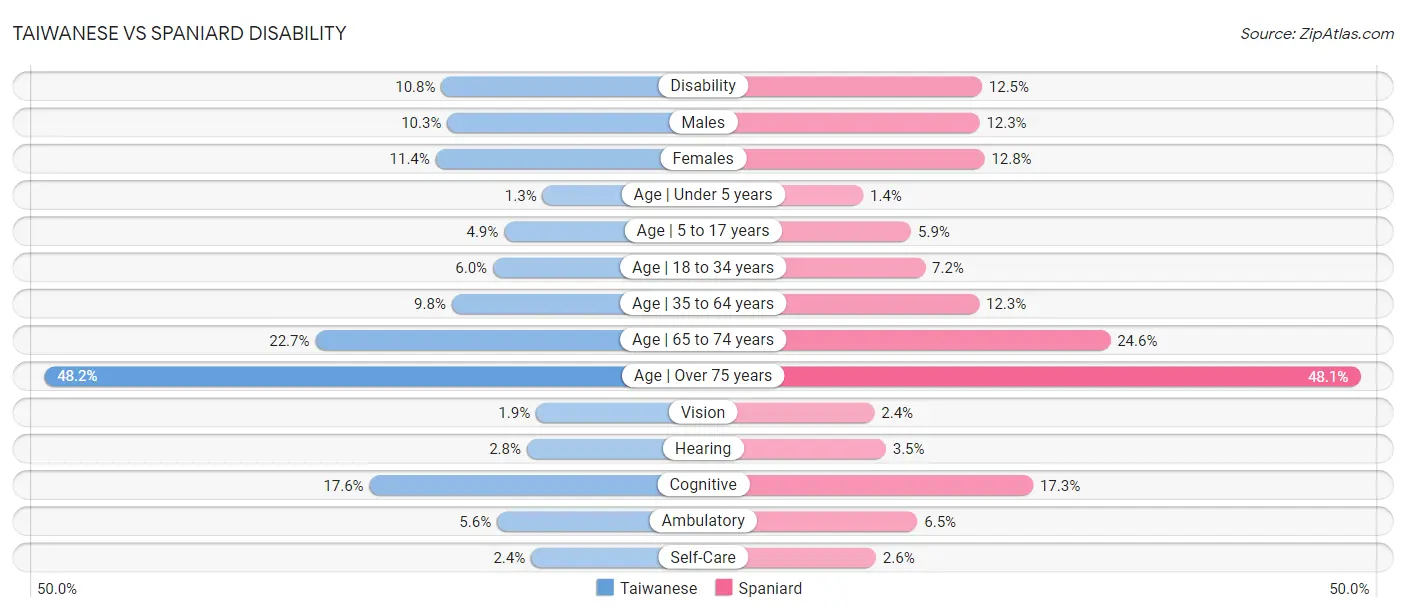
| Disability Metric | Taiwanese | Spaniard |
| Disability | Exceptional 10.8% | Tragic 12.5% |
| Males | Exceptional 10.3% | Tragic 12.3% |
| Females | Exceptional 11.4% | Tragic 12.8% |
| Age | Under 5 years | Tragic 1.3% | Tragic 1.4% |
| Age | 5 to 17 years | Exceptional 4.9% | Tragic 5.9% |
| Age | 18 to 34 years | Exceptional 6.0% | Tragic 7.2% |
| Age | 35 to 64 years | Exceptional 9.8% | Tragic 12.3% |
| Age | 65 to 74 years | Excellent 22.7% | Tragic 24.6% |
| Age | Over 75 years | Tragic 48.2% | Tragic 48.1% |
| Vision | Exceptional 1.9% | Tragic 2.4% |
| Hearing | Exceptional 2.8% | Tragic 3.5% |
| Cognitive | Tragic 17.6% | Average 17.3% |
| Ambulatory | Exceptional 5.6% | Tragic 6.5% |
| Self-Care | Exceptional 2.4% | Tragic 2.6% |